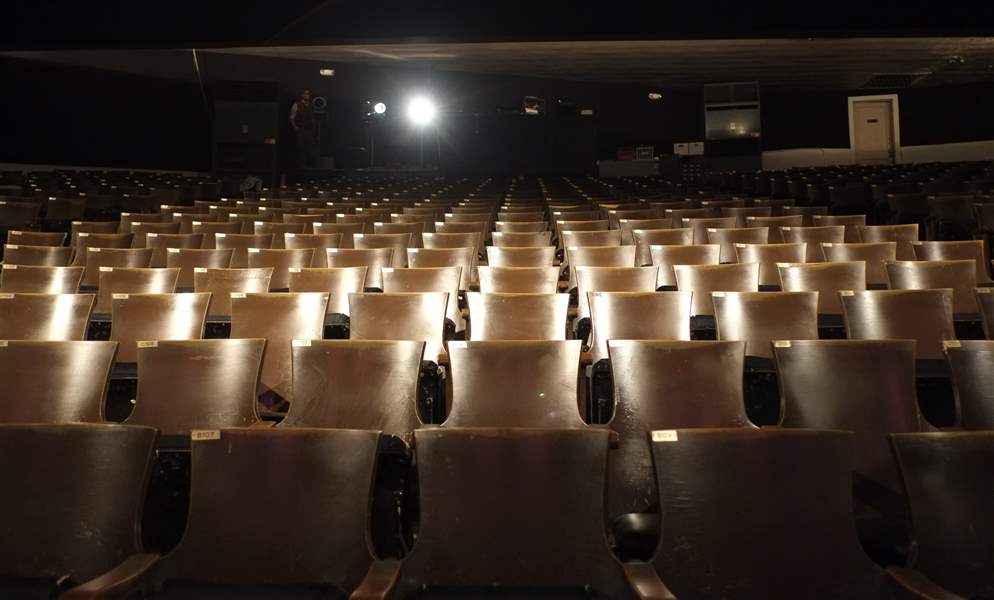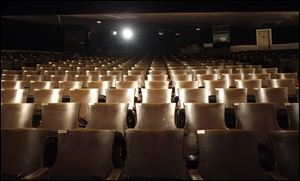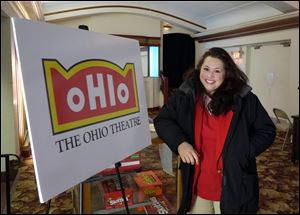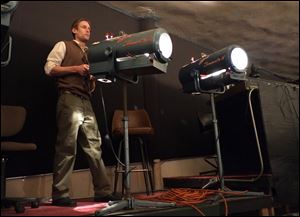
Art house theaters struggle for comeback in Toledo
2/23/2014
The Ohio Theatre on Lagrange Street in Toledo.
The Blade/Dave Zapotosky
Buy This Image

The Ohio Theatre on Lagrange Street in Toledo.
For anyone as passionate about film as Nate Rethon, living in northwest Ohio presents a significant challenge.
Toledo has no dedicated art house theater to showcase important, acclaimed, and avant-garde independent releases, foreign films, documentaries, and Hollywood’s limited-run smaller movies. And the handful of small-budget, artistic-minded efforts that do trickle into local theaters are often here-and-gone vanishing acts.
And so the 28-year-old Perrysburg resident and his wife spend weekends as far as Columbus and Chicago to take in movies they can't in Toledo.
“Basically, anywhere reasonably close by that has what we want to see — and that’s not the most convenient thing in the world,” Rethon said. “We have a passion for it and a lot of our friends have a passion for it, and not having that opportunity in Toledo has been a challenge living here.”
The Rethons' travails soon may be over.
The Ohio Theatre on Lagrange Street reopened in May with the expanded title of the Ohio Theatre and Event Center under the ownership of nonprofit community developer United North, which has plans for the historic three-story brick-and-stone masonry building to become Toledo’s only first-run specialty theater as early as late spring.
“It is our full intent to have first-run art films and documentaries and films you might not otherwise see at the big-box movie theaters," said Nikki Morey, senior manager of community programming for United North. “We’ll offer a steady stream of movies. That is our intent.”
As part of its commitment to serving the cultural needs of the community, United North, which purchased the 600-seat theater in 2009, will also maintain a monthly schedule of poetry readings, concerts, plays, dance recitals, and will most likely relegate its film showings to once per night.
Still, for those who favor subtitles to special effects, the United North’s plan for the classic theater is undoubtedly a cause for celebration. The question is: Will they support it?
HISTORY
Toledo’s best-known art house theater was the Glynbyrne Cinemas I and II.
Located in a strip shopping center at Glendale Avenue and South Byrne Road, the two-screen theater served the “small but dedicated” community of alternative film lovers for more than a decade in the late 1970s and through the ’80s, as well as the mainstream movie-goers with discounted second-run films. Ultimately, the support wasn’t enough and the Glynbyrne closed Dec. 31, 1990. Weeks later and Toledo’s other specialty films showcase, Sommerset Cinema, shuttered as well.
Toledo was without an alternative movie house until years later when the 10-screen Super Cinemas complex in Springfield Township began to show first-run art films in several of its auditoriums in addition to its already popular discount movies.
“No matter when you would go, [art films were] always well attended,” recalled Jason Hickey, a 34-year-old Maumee resident. “I would spend an afternoon there watching movies. To know there was an audience for these films was very nice.”
But by 2008 Super Cinemas’ owner, National Amusements Inc., of Dedham, Mass., said its theater was “no longer financially” viable and closed the nearly 20-year-old complex in April of that year. Art films were subsequently consigned to National Amusements’ Showcase Cinemas Levis Commons theater in Perrysburg, where the bulk of these movies continue to appear part time under the new ownership of Cinemark.
“It was really unfathomable when it closed,” Hickey said of Super Cinemas, “and there’s been a void ever since.”
BUSINESS MODEL
Movie theaters devoted to alternative programming are not ATMs for their owners.

Nikki Morey is the senior manager, community and programming, for United North.
“It’s certainly not a business venture if you’re looking for quick returns,” said Jonathan McNeal, the general manager of The Neon, a long-running independent art theater in Dayton. “You’ve got to have someone very passionate behind it.”
And often, even that’s not enough. The margin between profitability and financial distress is extraordinarily narrow for such business endeavors — especially when compared to the conventional cineplex, which has the revenue stream of Hollywood hits and packed auditoriums to offset film flops.
“We had our best year ever last year and our best weekend ever a few weekends ago, but we’re not swimming in cash,” McNeal said. “But we’re doing well enough to stay open.”
McNeal largely credits The Neon’s survival to a smallish group of devoted movie lovers he calls “the NPR crowd.” Emily Mathews, the marketing director at The Michigan Theater in Ann Arbor, said a similar group's dedicated patronage has kept her nonprofit theater going for 30 years.
“We have a membership program [with] about 5,000 members. Those people are so loyal that even if a movie opened [at another theater in town] and our theater, they will come here,” she said. “They understand how important their support is.”
Keeping an alternative theater running is pricey. In addition to the operational expenses, there are significant costs to showing the films. A movie house is responsible for the film buyer’s fees, which includes licensing the film, as well as the hard costs connected with acquiring the movie, such as shipping. Theaters also share a sizable chunk of the box-office sales with the film’s studio/distributor, though the percentage decreases in the theater’s favor the longer a movie sticks around. Still, a theater is often paying out thousands of dollars per film.
“It’s not cheap,” said Jan Klingelhofer, owner and president of Oakland-based Pacific Film Resources, the film buyer for a number of specialty art houses nationwide, including The Neon, The Michigan Theatre, and The Cedar Lee in Cleveland Heights.
That may not bode well for the survival of The Ohio Theatre, located in an area of town some might consider rough. Meanwhile, those artier films that are shown at Levis Commons or Franklin Park 16 often play to sparse audiences.
Cinemark did not respond for comment, though Klingelhofer offered that multiplexes and art houses don’t necessarily share moviegoers — even for the same films. The more commercial Oscar bait American Hustle attracted bigger crowds at the mainstream theaters, while the black-and-white character drama Nebraska — which disappeared quickly at Franklin Park — played to larger audiences at smaller specialty theaters.
“It’s a different experience,” she said.
THE VALENTINE
If there is a barometer for the success-fail prospects of The Ohio Theatre, it might be downtown Toledo’s Valentine Theatre’s inaugural “Arthouse Film Series.”

Jan Czernik is the manager of the Ohio Theatre.
The Feb. 9 double-bill of Ingmar Bergman’s The Seventh Seal and Akira Kurosawa’s Rashomon — classics of the art film tradition — drew only 30 patrons, “and it was well-publicized,” said Matt Lentz, director of marketing and public relations for the Valentine.
Meanwhile, The Ohio Theatre’s December program of family classic Christmas movies such as White Christmas and A Christmas Story drew only a handful of moviegoers, and United North took a $500 loss.
Even Morey isn’t certain that there’s a consistent local audience to support anything more than twice-monthly art film screenings. “I would love to be proven wrong and I would love to be able to expand so that we’re running something different every weekend and the audiences come so it’s beyond our breakeven point,” she said. “... At this point we’re struggling to get an audience.”
United North has applied $1.2 million it’s received in various donations and grants for renovations of the 93-year-old Ohio Theatre, a cornerstone in its plans to revitalize ONE Village, which has seen the success of a soul-food diner across the street, and strong attendance for some evening events at the theater, which has access to approximately 100 nearby parking spaces.
Terry Glazer, CEO of United North, is busy applying for even more financial assistance.
The solicited funds and patron participation, he said, helped United North break even on the building’s operations for 2013 – and the nonprofit organization has the deep pockets and resources to keep the theater afloat until the patrons do.
There is a niche audience for the films and other cultural events offered by the Ohio Theatre, Glazer said. “And we don’t need a big niche to make it work.”
Contact Kirk Baird at kbaird@theblade.com or 419-724-6734.